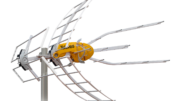Lately there has been a lot of talk about 5G. This tech was going to be the absolute biggest thing there ever was, and I think that honestly most of that hype fizzled. 5G is better than LTE, except of course when it isn’t. I think most of the time it is faster, especially if you live somewhere with “5G+” service. On the other hand, 5G signals have a tendency to work poorly over larger distances, and that’s where LTE still beats it.
One of the things that’s being talked about lately is 5G filtering. Most of our Televes antennas will filter 5G signals and you’re starting to see some companies with standalone 5G filters. But is it worth it? Is this even a problem, or is it just something that the antenna companies cooked up to sell you something?
On the other hand, if it’s true that TV antennas do pick up 5G, does that mean your average TV antenna could do a better job than your average cellular antenna, if you hooked it to a cell booster? Is that something you should consider if you’re looking for the best performance from your cell phone signal booster?
Time for some straight talk
OK, here’s the truth. Most cell phone signals, including 5G, use the frequency range from 600-850MHz. Some use a range up in the 1800-2200MHz range and others, like “5G+”, use frequencies way up above 20,000MHz. But let’s focus on the 600-850 range right now. These frequencies were first used for 3G signals, and when the major carriers stopped using 3G, they gave those frequencies over to 5G.
What you need to know about the 600-850MHz range is that it was, yes, originally used for TV broadcasting. Because of the tech back in the mid-20th century, you needed a lot of space between broadcast channels. It wasn’t just a technical limitation, it was the law. So in order to have 15-20 broadcast stations on the air like New York and Los Angeles did, you needed about 80 broadcast channels.
Remember at the time there was no internet, and broadcast TV was pretty much the only way to get live video. Back then, everyone expected TV to keep growing and growing. Well, we know it didn’t.
Here’s what really happened
What really happened was, broadcast frequencies originally used for television were given over to other purposes. Originally, TV channels ran up to 83. Channels 70-83 were taken first, followed by 51-69. By the time TV went digital, the tech was better, the growth spurt was over, and you just didn’t need all those extra channels. In the late ’10s, TV station frequencies were reshuffled so that broadcasters only used 54-550MHz, or to put it another way, channels 2-35.
What happened to those other frequencies? Most of them were given over to cell phone communication. You hardly need me to tell you that cell phone use exploded in the 21st century especially when smartphones came on the market. People’s appetites for streaming video meant high demand for those frequencies.
As a result, frequencies in the 600, 700, and 850MHz range are used for cellular communications even though they were originally used for broadcast TV. And as I said, though they were originally used for 3G, today they’re used for 5G.
How big of a problem is this?
Like most things, it isn’t a problem until it is. For the most part, TV and cellular broadcasts can live quite happily together. TV broadcasts are “horizontally polarized,” meaning the waves go left-to-right. Cell communication uses “vertically polarized” signals, meaning the waves go up-and-down. This should mean that there is next to no interference between them, even when the frequencies are very close.
However, interference does happen. If you are very close to a cell tower, close enough to see it clearly, the cell signal could be strong enough to overpower the weaker broadcast signal. This will show up on your TV as a repeating pattern of quick glitches every few seconds. It won’t be on every channel, but because of some of the math involved, it’s not always going to be the same channel for everyone.
If you are seeing something like this happen to you, you’ll want to get an antenna with a 5G filter. Call the experts at Solid Signal to help you find the right one. We’re here for you at 888-233-7563 during East Coast business hours. If it’s after hours, fill out the form below. We’ll get right back to you!
What about using a TV antenna as a cellular antenna?
Truth is, TV antennas don’t make very good cell antennas. They’re designed to pick up a lo of signals besides those in the 5G range, and they don’t pick up the AWS frequencies at 1800-2200MHz that are still used for LTE by some carriers. Plus, you’d have to turn your antenna at 90 degrees to get those vertically polarized signals very well. You’re better off staying with the antenna that came with your cell phone signal booster.





